by T. Sabaratnam, April 21, 2004
Volume One Index
Original index to series
Introduction
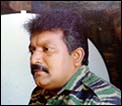
Pirapaharan 2001
In the first volume, I chronicled the birth, childhood, growth and the political environment which conditioned the thinking of Pirapaharan.
His was a conservative family. His father, Velupillai, was a land development officer in the Sri Lankan government whose ambition was to educate his children and have them join the government service, especially the last of the four whom he wanted to enter the Ceylon Civil Service, the pinnacle of the state services. Pirapaharan’s elder brother, Manoharan, fulfilled his father’s wish and his sisters, Jagatheeswari and Vinothini, were married to government servants holding respectable positions.He was born into a devout Hindu family, trustees of one of the famous Hindu temples in the Jaffna peninsula. He grew up in a highly religious environment which his mother, Parvathy, scrupulously maintained in her home.
Pirapaharan grew up in an affectionate atmosphere. He was the beloved of the family and the darling of the neighbours. He was loved by all and he loved them in return. In his interviews, he has admitted that he had a pleasant childhood.
His father was not overbearing. He treated his children with love and understanding. He set them an excellent example. He was a model father. He enjoyed the respect of the people of his village.
Pirapaharan was provided with all the facilities he needed to study and grow up in the traditional mould his society had set for him. Valvettithurai, originally a trading and ship building port of the Jaffna peninsula and later a smuggling center, was transforming itself during Pirapaharan’s childhood into a village that produced loyal and efficient government servants.
In childhood, Pirapaharan’s father encouraged him to listen intently and instilled in him a keen sense of political awareness and social consciousness. He was allowed to listen to their evening discussions. He was encouraged to read widely. He was taken to religious discourses. He was permitted to attend political meetings. All these honed his inborn political acumen.
Pirapaharan was thus born into and grew up in an ideal family. Then what turned him into a rebel?
I have tried to answer this question in my first volume.
Briefly, he was the product of his environment.
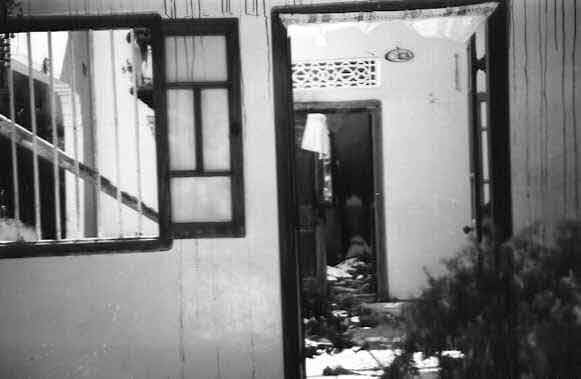
Tamil home destroyed in 1958 pogrom
Most of the Tamil youths of his time reacted the way Pirapaharan did. They were all hurt when their language was denied an official status. They were all annoyed when their leaders who exercised their fundamental democratic right of peaceful protest were insulted and assaulted by Sinhala thugs. They were all furious when Sinhalese mobs attacked and burnt Tamils and their houses.
Tamils as a community, especially the youth, felt slighted by the policies and actions of the Sinhala leaders and the mobs which these leaders unleashed on them. They developed a sense of grievance against the Sinhala rulers. Some of the youths, the most sensitive in the community, started thinking of hitting back.
I have sketched the political events of that time and delineated the causes in detail to enable readers understand and appreciate the phenomenon of Tamil armed rebellion. The original causes for Tamil resentment were: state-aided Sinhala colonization of Tamil land and the disfranchisement of Indian Tamils. These actions were meant to weaken and marginalize the Tamil community. Actions on these fronts commenced long before Sri Lanka gained independence from British rule on 4 February 1948. They were well planned.
Reduction of the extent of land under the control of the Tamil community was the target of the Sinhala colonization schemes. Tamils occupied the northern and eastern provinces which they claimed as their traditional areas of habitation. Sinhala leaders took over large extents of fertile agricultural land in both provinces by settling Sinhala peasants in Ampara, Trincomalee and Vavuniya districts. Through these state-aided colonization schemes Sinhala leaders not only reduced the extent of land under Tamil occupation, but also increased the Sinhala population, thus turning the Tamils living in those areas into a minority community. The result of this action is now clear. Three Sinhala majority electorates, Ampara, Seruvila and Vavuniya South have been implanted within the Tamil majority northern and eastern provinces. And, through them, the northeast sends Sinhala representatives to parliament.
Reduction of the numerical strength of the Tamil community who constituted 18 percent of the total population was the target of the disfranchisement of the Indian Tamil community. This was done by barefaced deception. The Sinhala leaders insisted that Sri Lanka should have the right to decide who its citizens were after independence. The minority communities agreed on an assurance that their interests would not be harmed. The very first legislation the Sinhala leaders enacted was to harm the Indian Tamils, an important section of the minority communities. The Citizenship Law took away the citizenship rights a million Indian Tamils had enjoyed while the country was under the British rule. By that act, the Sinhalese leaders reduced the numerical strength of the Tamil population to 12 percent.
The following table copied from Indian Tamil leader, the late S. Handyman’s autobiography, Tea and Politics, is revealing. The reduction in the voter strength of the seven electorates that elected Indian Tamils to Parliament in the 1947 election following the enactment of the Citizenship Law is given in this table.
The Effect of the Citizenship Law on the voting
Strength of the Indian Tamils
| Constituencies | 1947 election | 1951 revision | |
| Nuwara Eliya | 24,295 | 319 | |
| Talawakelle | 19,299 | 244 | |
| Kotegala | 17,092 | 137 | |
| Nawalapitiya | 22,580 | 675 | |
| Maskeliya | 24,427 | 203 | |
| Haputale | 11,123 | 322 | |
| Badulla | 43,396 | 1,291 |
Naturally, Tamils were hurt. They felt that they were deceived. They realized that they were being marginalized. They understood that they were being reduced to a subject race. They recognized that the constitutional framework which the British had crafted for independent Sri Lanka was the main cause for their plight. Democracy, being essentially the rule by the majority, gave the numerically stronger Sinhalese community the state power which they used to marginalize the Tamils.
A section of the Tamil leaders decided that a federal system of government, which permitted a degree of autonomy for the regions, was the only safeguard available to the Tamil community. They formed a separate political party in 1949, a year after independence, and named it the Federal Party. They elected a leading lawyer, Samuel James Chelvanayakam, their leader.
The Federal Party placed before the country a federal structure for the governance of Sri Lanka. It should comprise a central government and five state governments. The proposed five state governments were: 1. State consisting of Western and Southern provinces. 2. State consisting of North Central and North Western provinces (ancient Rajarata). 3. State comprising Uva, Sabragamuva and Central Provinces (former Kandiyan Kingdom). 4. State comprising Northern Province and Trincomalee and Batticoloa districts of the Eastern Province (predominantly Tamil areas) and 5.State consisting of the Ampara district of the Eastern Province (predominantly Muslim area).
The Federal Party also said the central government would deal with the subjects common to the country such as external relations, defence, law and order, police, citizenship, immigration and emigration, customs, irrigation, air travel, railway, inter-state travel, ports, etc. Other subjects were to be allocated to the state governments, which would be elected.
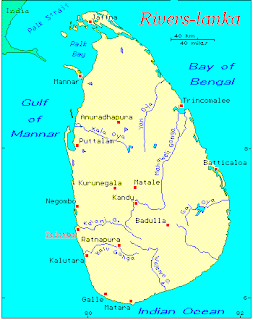 Prime Minister D. S. Senanayake, who was instrumental in commencing the colonization schemes – the Gal Oya Scheme in Ampara and the Kanthala scheme in Trincomalee district and who disfranchised the Indian Tamils, dismissed the federal solution as a ‘scheme to divide the country’ at a meeting he addressed in Jaffna in 1951. D. S. Senanayake’s pronouncement that federalism means division is kept alive by Sinhala racists even today.
Prime Minister D. S. Senanayake, who was instrumental in commencing the colonization schemes – the Gal Oya Scheme in Ampara and the Kanthala scheme in Trincomalee district and who disfranchised the Indian Tamils, dismissed the federal solution as a ‘scheme to divide the country’ at a meeting he addressed in Jaffna in 1951. D. S. Senanayake’s pronouncement that federalism means division is kept alive by Sinhala racists even today.
The Federal Party placed its federal proposal before the Tamil people in the northeast for the first time during the 1952 parliamentary election. It fielded seven candidates but only two won, C. Vanniyasingham at Kopay and N. E. Rajavarothayam at Trincomalee. Chelvanayakam was defeated. The Tamil people showed through this election that they still placed their faith with the Tamil leaders who opted to work with the Sinhala leadership.
The environment soon changed among the Sinhalese and the Tamils. The change, incidentally, occurred in the very year Pirapaharan was born. He was born on 26 November 1954. About six months before his birth, in April 1954, the All Ceylon Buddhist Congress, appointed the Buddhist Commission headed by Arthur Wijewardene, a retired Supreme Court Judge. His mission was to identify “the disabilities Buddhists faced under foreign rule.”
The Buddhist Commission sat in all major cities in the south to record evidence. Many leading Sinhala Buddhists and Buddhist organizations gave evidence. They identified the disabilities the Sinhala Buddhists faced during foreign rule and under the UNP, which had ruled the country since independence, into two categories: neglect of the Sinhala way of life which included language, religion and culture and the dominance of the Tamil people in all walks of life and the economy. The proceedings generated considerable nationalist fervor among the Sinhala people.
An agitation to restore Sinhala pride through the enactment of Sinhalese as the official language and the marginalization of the influence of the Tamils sprang up among the Sinhalese. Secret societies like the Dutugemunu Force, which spearheaded a movement to send the Tamils back to India, also were formed. The Dutugemunu Force distributed leaflets warning the Tamils to quit the country and attacked Tamil businessmen and professionals.
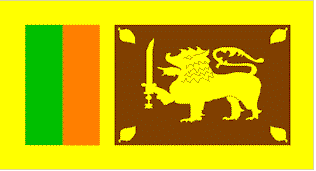
Sri Lanka’s lion flag
The emergence of Sinhala nationalism had its impact on the Tamil people. The Tamil community felt endangered. Apart from this factor, nationalism was growing among the Tamils on its own during this period due to internal and external causes. Internally, it was whipped up by the Tamil Congress during its evidence to the Soulbury Commission and during the 1947 parliamentary election. The Tamil Congress slogan, ‘Call yourself a Tamil and hold your head up,’ generated a high degree of passion among the Tamils. The national flag dispute injured Tamil pride. Tamils resented the choice of the Lion Flag, the flag of the Sinhala people, as the main component of the national flag. Externally, the Tamil nationalistic feelings generated in Tamil Nadu by the Dravidian Movement had its impact on the Sri Lankan Tamils.The years 1954 to 1956 saw this parallel growth of Sinhala and Tamil nationalisms reach their crescendo. Sinhalese and Tamils were proud communities with highly developed ancient civilizations. If both had been accommodated they would have added richness to the fabric of Sri Lankan life.
That was not to be. The nations collided. The recommendations of the Buddhist Commission were the main cause. In its 124-page report released on 4 February 1956, the fourth independence anniversary, the Commission identified the neglect of the Sinhala language and the dominance of the Tamils in all walks of life as the main causes for the disabilities suffered by the Sinhala people. The Commission also rekindled in the Sinhala psyche the two concepts implanted by the 6th Century Buddhist chronicle, the Mahawamsa: the Sinhalese, as the original settlers of the island, are rightful owners of Sri Lanka and Sri Lanka had been chosen by Lord Buddha as the home of Theravada Buddhism.
The Buddhist Commission created among the Sinhala people an attitude of mind that they are the rulers of the country and that only their opinions and interests matter. It also generated among the Sinhala people an attitude of hostility and intolerance towards the Tamil people. The Sinhala people were told that Tamils were foreigners, invaders and if they want to enjoy their rights they should go back to South India where they really belong.
The newly formed political party, the Sri Lanka Freedom Party (SLFP) grasped the leadership of the emerging Sinhalese nationalist forces. The new party was formed in 1951 by Solomon West Ridgeway Dias Bandaranaike, an Oxford-educated liberal, who resigned from D. S. Senanayake’s cabinet. His party won only nine seats in the 1952 election, which the conservative United National Party swept, capturing 54 seats in the 101-member parliament. With the six nominated members, four Tamil Congress parliamentarians and a few independents, Dudley Senanayake formed his cabinet. Bandaranaike realized that he could only push the UNP out of power by providing leadership to the Sinhala nationalist forces.
Dudley Senanayake resigned following the 1954 August hartal and Sir John Kotalawela took over the premiership. He failed to realize the socio-cultural change that was taking place in the Sinhala society and its impact on national politics and on Tamil society. Handy Perinpanayagam voiced the Tamil apprehension when Kokuvil Hindu College, at which he was principal, accorded a reception to Sir John when he visited Jaffna in 1985.
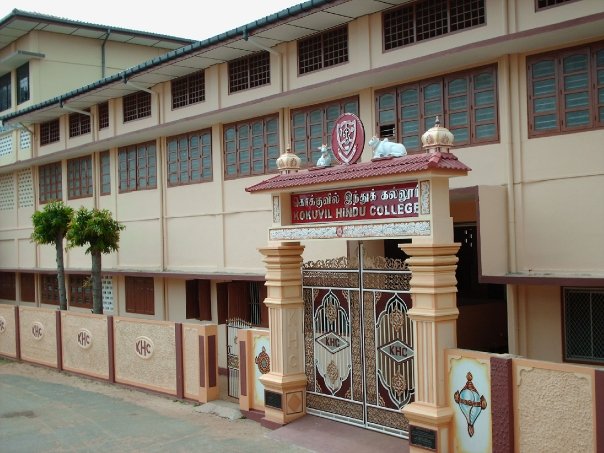
Kokuvil Hindu College
Perinpanayagam politely requested Sir John clarify the UNP’s language policy. Sir John replied that the UNP was for making Sinhala and Tamil the official languages of Sri Lanka.
Sir John’s statement upset the hornet’s nest. All Sinhala Buddhist organizations joined hands in opposing Sir John’s assurance. They chorused that they wanted Sinhala only to be the official language. Bandaranaike and his SLFP provided the leadership. He brought all the anti-UNP forces together and formed a political alliance known as the Mahajana Eksath Peramuna (MEP), a conglomerate of Sinhala chauvinists, Buddhist fanatics and Marxixt opportunists. Bandaranaike then placed his Sinhala Only slogan before the country.
Sir John somersaulted when Sinhala Only enthusiasts in his party pressed him to change his official language policy. He fixed the UNP annual session for 18 February 1956 and announced that the sessions would adopt the resolution to make Sinhala alone as the official language. The UNP’s response to the MEP’s Sinhala Only policy was ‘Sinhala Alone.’
Denial of Tamil rights had thus been made an election issue. The two main Sinhala political parties, the UNP and the SLFP, vied with each other to prove that they served Sinhala Nationalism better. Since that time the two main Sinhala political parties – the UNP and the SLFP – have made the denial of Tamil rights their main concern. The contest for denial of Tamils their legitimate place emerged as the election politics of Sri Lanka. The party that demonstrated to the people that it was capable of harming the Tamils more won the elections.
Tamils in the UNP were disturbed. They gave the UNP Working Committee a counter resolution and sought to move it in the annual sessions. It had two parts. The first portion said Sinhala and Tamil should be the official languages. The second portion said that if the sessions adopted the resolution that Sinhala alone should be the official language, then the Tamil majority northern and eastern provinces should be allowed the right to secede and form a separate state called ‘Eelam.’ The Working Committee refused permission to place this resolution on the agenda. Seven Tamil Members of Parliament, headed by Posts and Broadcasting Minister S. Nadesan, resigned from the UNP when the UNP adopted the Sinhala Alone resolution. They were followed a few days later by other Tamil parliamentarians.
The reaction of the Tamils was to strengthen the Federal Party, which advocated a federal solution for their problem. The Tamil people swung in favour of a federal solution, while the Sinhala people overwhelmingly adopted Sinhala Only as the country’s official language. Thus the division between the Sinhala and Tamil people had been sealed even before the Sinhala Only law was enacted by the new Bandaranaike government on 5 June 1956.
In the 1956 election, the Federal Party contested in 14 seats and won ten and 142,036 voters backed it, a three-fold increase from the 45,331 votes it gathered in the 1952 election. Tamils had rejected the Tamil Congress and the Tamil candidates of the UNP who backed the policy of working with the Sinhalese leadership to win their rights.
This was the environment when Pirapaharan was born on 26 November 1954. Sinhala nationalism and Tamil nationalism were pitted against each other. The Sinhalese wanted to dominate the country and the Tamils wanted to get out of that danger by setting up an autonomous state for themselves, under a federal conmstitutional structure.
The situation worsened during Prabakaran’s childhood. I have sketched in detail the mob attack unleashed on the Tamil leaders who exercised their democratic right of peaceful protest when they performed satyagraha at Galle Face Green on 5 June 1956 and the subsequent attacks on the Tamils in Colombo and the riots in Gal Oya.
Pirapaharan was too young to be aware of these indignities, but Tamil people, as a community, felt insulted, humiliated and threatened. That feeling of hurt was aggravated two years later, in May 1958, when Sinhala mobs attacked and burnt Tamil shops and houses around the country, mainly in provincial towns and rural areas. Two incidents, the burning of the Hindu Priest at Panadura and the throwing of children into boiling tar drums in Colombo pained the Tamils acutely. Pirapaharan was then three and a half years old and, when he heard about the incidents his innocent reaction, was: Why can’t we hit back?
Many seniors felt the same way. Why should we take these indignities lying down? Why can’t we hit back?
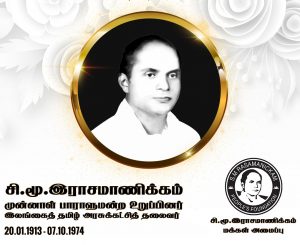
S M Rasamanickam
The organized leadership of the Tamils at that time was with the Federal Party and its Gandhian leader S. J. V. Chelvanayakam, popularly known as Thanthai Chelva, who preached non-violent democratic agitation as the way to win Tamil rights. His dominant influence smothered all budding thoughts of “hitting back” and even those who dared to fall out of line gave up their revolt when the Sinhala leadership showed signs of accommodating the aspirations of the Tamil people.
That was what happened to Puli Padai, the Army of Tigers, the first secret organization of Tamil youths formed in 1961 to commence an armed revolution. On 12 August 1961 about 20 young members of the Federal Party, which included a civil servant and men holding high positions in the government, gathered at the historic Thirukkoneswaram Temple in the harbour town Trincomalee and, after attending the morning pooja, walked up the holy rock and vowed, facing the rising sun, to commence an armed struggle to win their rights for the Tamils.
The group started a shipping company to smuggle in arms and commenced a campaign to motivate young men. Their venture failed because Tamil people still retained the hope of winning accommodation from the Sinhala people through non-violent, democratic means. The anger the 20 young men had at the Sinhala leadership ebbed when, in 1965, Dudley Senanayake signed an agreement with Federal Party Leader S. J. V. Chelvanayakam and formed a National Government, with the Federal Party as a partner.
Dudley Senanayake’s failure to honour his promises brought in another factor which hardened the distrust the Tamil people had about the Sinhala leadership’s ability to act fairly by the Tamils and its capacity to go against the chauvinistic Buddhist monks. Earlier, in 1958, Prime Minister S. W. R. D. Bandaranaike had toren up a pact he had solemnly signed with Chelvanayakam when a small group of extremist Buddhist priests sat opposite his private residence and demanded him to abrogate the pact. Dudley Senanayake went a step further and denied the very existence of an agreement he had signed with Chelvanayakam.
Pirapaharan was at Chithampara College and attending a private tutory where these acts of the Sinhala leaders were discussed and the distrust of the Tamil people in them were analyzed. At the tutory, he came under the influence of Venugopal Master who planted in his young mind the thought that the Sinhala leaders lacked the capacity to defy the wishes of the Buddhist priests who lived in the belief that Sri Lanka is a Sinhala Buddhist country and that Tamils are foreigners. The only option available to the Tamils was armed revolution was the conclusion reached.
Groups of youths of Valvettithurai, all senior to Pirapaharan, had become adherents of armed revolution and children of his age were freely talking about fighting the police and the army. In the Jaffna peninsula armed revolt was talked about in secret. Thangathurai and Kuttimani had become known names.
Pirapaharan grew in an environment in which Tamil opinion hardened. The Tamil people who had opted for a federal solution in 1956 reaffirmed their conviction in the parliamentary elections of 1960 March, 1960 July, 1965 and 1970. But the Sinhala leadership spurned their aspirations and crushed all the non-violent agitations their leaders launched.
The state repression the Sinhala governments unleashed activated the Tamil youths and brought them to the fore. In the first volume of this series I have described the emergence and growth of that factor. These feelings have only grown stronger after 1970 when Sirimavo Bandaranaike interfered with education and employment opportunities enjoyed by the Tamils and wrote into the constitution that Sri Lanka is a unitary state, thus denying the Tamils any possibility of a federal constitutional arrangement.
Pirapaharan joined the revolting youths and formed his own armed group – the Tamil New Tigers – in 1972 soon after the enactment of the 1972 constitution. The revolt grew as Sirimavo Bandaranaike had closed the democratic, non-violent option of a federal solution the moderates placed before the Tamil people.
The Sinhalese leaders and political commentators have failed to give adequate attention to the impact of the 1972 constitution on the Tamil struggle. Thanthai Chelva tried to save the situation even after the 1972 constitution. He resigned his seat when the youths asked the Tamil parliamentarians to quit parliament and declare the northeast independent. Sirimavo Bandaranaike on the insistence of Felix R. Dias Bandaranaike, the most powerful minister in her government, played childish politics by postponing the Thanthai Chelva’s by-election. Felix R. Dias Bandaranaike’s main concern at that time was his ‘fight’ with Finance Minister Dr. N. M. Perera.
When the by-election for the Kankesanthurai seat was finally held on 6 February 1976, the mood of the Tamil people had changed. They were angry with the Sinhala leadership. The youths made use of the by-election to express their anger. They worked hard to make Thanthai Chelva win with a massive victory and greeted the victory as theirs, the push for a change of Tamil policy from federalism to a separate state.
Thanthai Chelva, in his victory speech, fell in line with the youth. He declared,
“Throughout the ages the Sinhalese and the Tamils in this country lived as a distinct sovereign people till they were brought under foreign domination. We have for the past 25 years made every effort to secure our political rights on the basis of equality with the Sinhalese in a united Ceylon. It is a regrettable fact that successive Sinhala governments have used the power that flows from independence to deny us our fundamental rights and reduce us to the position of a subject people. I wish to announce to my people and the country that I consider the verdict at the election a mandate that the Tamil Eelam nation should exercise the sovereignty already vested in the Tamil people and become free.”
Tamil youths raised the victory cry. They shouted ‘Tamil Eelam’ and nothing else. Almost all the Tamil militant leaders, including Pirapaharan, were there for Thanthai Chelva’s speech. They considered that they had helped the moderate democratic leadership to receive the mandate they needed. They realized that they had to undertake the task of implementing the mandate because the non-violence the moderate leadership preached had failed.
Pirapaharan transformed the TNT into the LTTE on 5 May 1976 and nine days later the moderate leaders formalized the Kankesanthurai election verdict into the Vaddukoddai Resolution. Pirapaharan heralded the birth of the armed revolution two months later with the killing of Alfred Duraiappah.
The Jayewardene regime, which assumed power in 1977, helped the formation and growth of the Tamil armed struggle through its shortsighted policy of state terror and political deception which weakened the moderates.
In the second volume, which I commence with this introduction, I will take the story up to Pirapaharan’s Suthumalai Amman Kovil Speech of 4 August 1987. I decided to begin the third volume with that historic speech (the photocopy of which I possess), because it marked an important milestone, a turning point, in the history of the Tamil freedom struggle.
In this volume which I start with the Thirunelveli attack, an event that pushed aside the democratic leaders and confirmed armed struggle as the effective weapon of the Tamil freedom struggle, I will show how Pirapaharan emerged the major player and the odds he had to overcome in this process.
I was fortunate that I was close to the Sri Lankan establishment and to the Indian High Commission in Colombo during this period. As a senior Daily News Deputy Editor I had the opportunity to meet most of them and interact with them. That access allows me an opportunity to give a complete picture of the Tamil freedom struggle during this critical period.
Next: Chapter 1. Thirunelveli Attack
To be published April 28